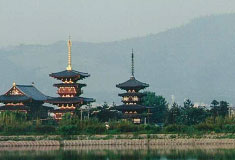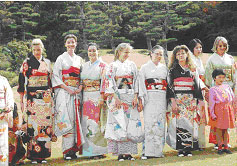- Schedule
- Todaiji Temple-->Nigatsudo Hall-->Kasuga Grand Shrine
- Meeting place: at the lobby of the New Public Hall at 13:15
- Fee: 500 Japanese Yen ( admission fee to Todaiji Temple )
- Todaiji Temple-->Nigatsudo Hall-->Kasuga Grand Shrine

09:05 - 12:20 Wednesday March 24th
- Schedule
- Meeting place: at the lobby of the New Public Hall at 09:00
- Fee: 930 Japanese Yen ( admission fee to Yakushiji Temple + city bus fee)
- Meeting place: at the lobby of the New Public Hall at 09:00
13:30 - 15:30 Thursday March 25th
- Schedule
- Meeting place: at the lobby of the New Public Hall at 13:25
- Fee: Free
- Meeting place: at the lobby of the New Public Hall at 13:25

Attraction iKoto&Shakuhachij
Player: uGroup Ibukiv
- Hiroko Yoshioka Masako Yoshioka @Sozan Nakamura
- Melody: Harunoumi Autumn Fantasy Letter Tagoto-no-tsuki
- Date : March 25, 2004
Q: This is a Koto? Itfs very large.
A: Itfs about 185 centimeters long and 26 centimeters wide.
Q: How many strings does it have?
A: Thirteen. Counting from the for side with the kotofs head to your right they are called one, two, threec up to ten, then to, i and kin.
Q: Which end is the head?
A: The koto is likened to a dragonfs body, and its parts are called the ryuhtoh (dragons head) and the ryuhbi (dragonfs tail). The ryuhtoh ?here?is a little wider than the rest.
Q: I see. So you play it with the ryuhtoh to the right. What are these things supporting the strings?
A: They are called ji, and their positions determine the pitch.
Q: Is it played with the fingers?
A: No, you play it with picks on the thumb and first two fingers of your right hand. These are Ikuta-school style, so the ends are square. The shape of the picks differs depending on the school and the type of koto. You press the strings with your left hand to raise the pitch or stop the vibration.
Q: I see. Well, please play something for me.
A: The koto originated in China and was brought to Japan in the Nara period. It is used as the primary instrument of gagaku, and called gakusoh. Koto music is called sohkyoku. What we think of as koto music today became established early in the Edo period and is called zokusoh. Schools of zokusoh include Ikuta, Yamada and Yatsuhashi. A still newer form of koto music appeared in the Taishoh period. A 17-string koto for lower notes and an 80-string koto for solo performances were introduced.
This bamboo flute, is named for its length, one shako, eight(hatch)sun, about 54.5centimeters.
Q: Recently I went to a performance of traditional Japanese music for the first time. I was overwhelmed by how wonderful the shakuhachi was. Its tone was sad, and yet stirring. Itfs got a quality completely different from the flute or oboe.
A: Ah, so you liked the shakuhachi. Itfs made by hollowing out the base of a bamboo, and has four holes in front and one in back. The forward part of the top is cut at an angle to form the mouthpiece.
Q: So itfs just a piece of bamboo with holes in it ! How can such a simple instrument produce such complicated tone color?
A: The trick is in the use of the fingers and the breath. The holes arenft simply open or closed. Sometimes they are halfway opened and sometimes only a fourth. And the player moves his jaw in and out, varying the distance between his lips and the mouthpiece to produce a subtle scale. And blowing forcefully will raise the note an octave. The shakuhachi has a range of about two-and-a half octaves.
Q: And it has a husky timbre that is very appealing
A: Yes, that breathiness itself is an important aspect of the shakuhachi.
Q: An art that blends the natural material bamboo with the human breathc The shakuhachi is a really simple instrument, with great depth, isnft it?
While an older form of shakuhachi was introduced from China in the 8th century, the modern instrument was developed in the Edo period when only komusoh, priests of the Fuke sect, were permitted to play the shakuhachi. They played at funeral services, when begging, and as a form of meditation. Only in the Meiji period did ordinary people begin to play the instrument.